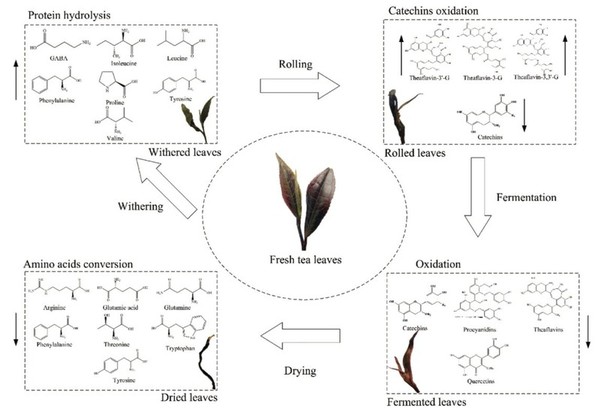New advances in quality chemistry and health function of black tea
Black tea, which is fully fermented, is the most consumed tea in the world. While being processed, it has to undergo withering, rolling and fermentation, which causes complex biochemical reactions of the substances contained in tea leaves and ultimately gives birth to its unique flavor and health effect. Recently, the research team led by Prof. WANG Yuefei from the College of Agriculture and Biotechnology, Zhejiang University, has made a series of progress in terms of the quality formation and health function of black tea.
By using sensory evaluation and metabolomics to analyze the effects of different processing parameters on the volatile and non-volatile compounds of Zijuan black tea, the team found that phenylacetic acid and glutamine were significantly correlated to the aroma and taste of Zijuan black tea, respectively, thus providing a reference for the optimization of the processing technique of Zijuan black tea (Zhao et al., LWT - Food Science and Technology, 2020). In subsequent studies, they found that oxygen concentrations could promote catechins, flavonoid glycosides and phenolic acids, and catechins oxidation could accelerate the degradation of amino acids to form volatile aldehydes and promote the oxidation of phenolic acids, thereby lowering astringency and bitterness and enhancing umami intensity, which provides a novel insight into the qualify formation of black tea. These research findings were published in an article entitled “Oxygen-enriched fermentation improves the taste of black tea by reducing the bitter and astringent metabolites” in the journal Food Research International in July, 2021.

Changes in nonvolatile metabolites during processing affect both the quality and potential health function of black tea. In November 2021, the team published an open-access article entitled “Nonvolatile metabolite alterations during Zijuan black tea processing affect the protective potential on HOECs exposed to nicotine” in the journal Food & Function. This study showed that leucine, isoleucine, and tyrosine were the main hydrolysis products during withering, and theaflavin-3-gallate (TF-3-G), theaflavin-3’-gallate (TF-3’-G) and theaflavin-3,3’-gallate (TFDG) were mainly formed during rolling. Moreover, oxidation of flavonoid glycosides, catechins and dimeric catechins occurred during fermentation. During drying, amino acid conversion became dominant. The changes of theaflavins, some amino acids and flavonoid glycosides had significant effects on the resistance of Zijuan black tea to nicotine-induced human oral epithelial cell injury, indicating that the enrichment of specific active ingredients and the enhancement of special functions of black tea by improving the manufacturing process of black tea may be an ingenious idea for tea product processing.

In December 2021, the team published another article entitled “Black Tea Alleviates Particulate Matter-Induced Lung Injury via the Gut-Lung Axis in Mice” in the Journal of Agricultural and Food Chemistry. This study demonstrated that PM (particulate matter)-exposed mice exhibited oxidative stress and inflammation in the lungs, which could be significantly alleviated by a daily intake of Zijuan black tea infusion in a concentration-dependent manner. Interestingly, both the ethanol-soluble fraction (ES) and the ethanol precipitate fraction (EP) exhibited better effects than those of TI. Furthermore, fecal microbiota transplantation (FMT) revealed that the gut microbiota was differentially reshaped by TI and its fractions were able to directly allay the injury induced by PMs. In addition, the Lachnospiraceae_NK4A136_group could be the core gut microbe contributing to the protection of EP. “These results showed that the daily intake of black tea and its fractions, especially EP, may alleviate PM-induced lung injuries via the gut-lung axis in mice, therefore providing theoretical references for the health function of black tea,” said Wang.